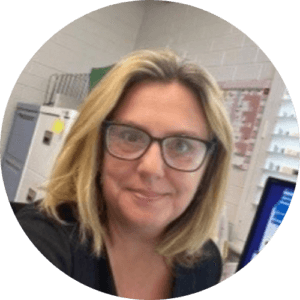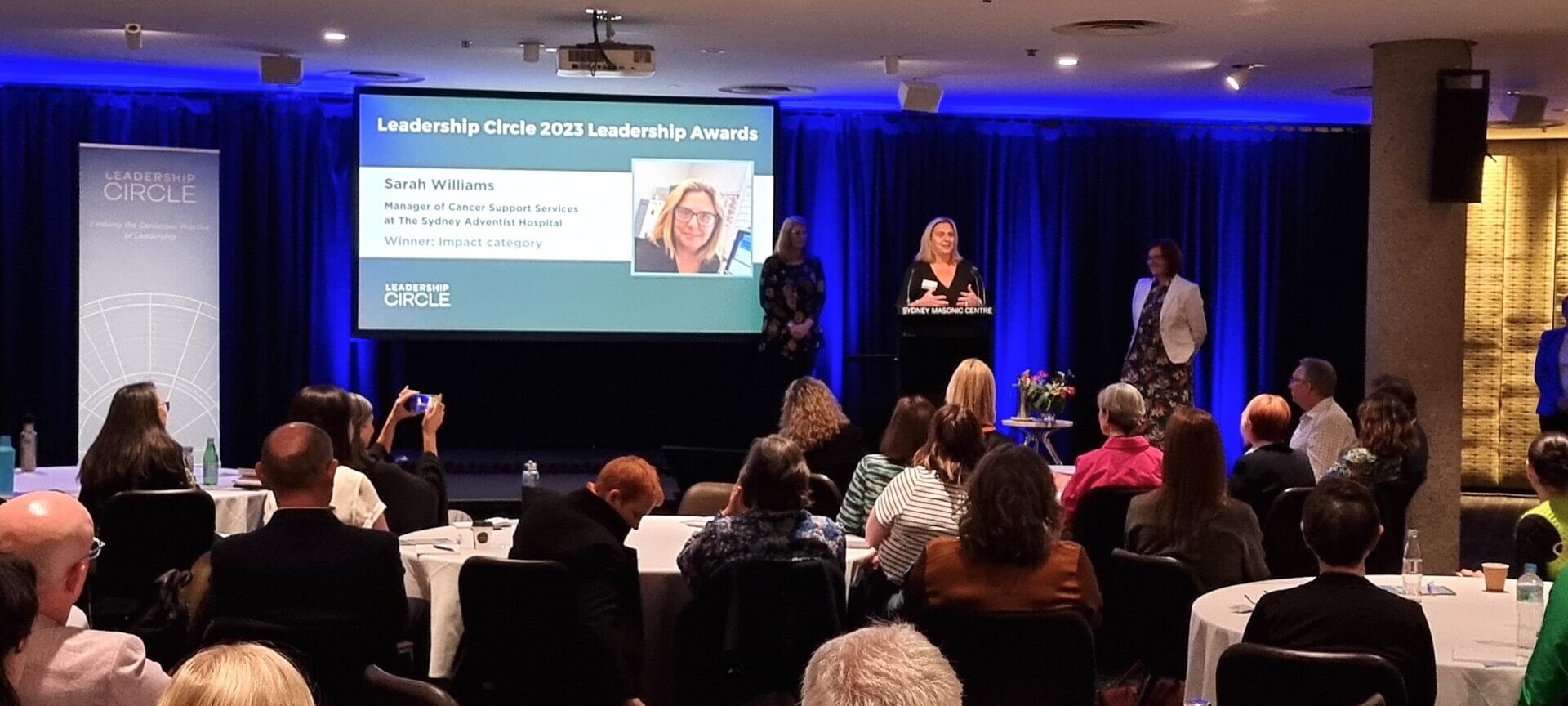Sarah Williams, Cancer Support Manager at The Sydney Adventist Hospital, on Creativity, Advocacy, and the Power of Teams

Sarah Williams
Sarah Williams is a healthcare leader in Cancer Support Services at The Sydney Adventist Hospital, and winner of the Impact ANZ Leadership Circle Award 2023, which recognises exceptional leaders who have a big impact on people and organisations achieving important goals.
In this article, Part 2 of 2, Sarah shares the leadership lessons she’s learned so far in her career, from the importance of creativity to team dynamics and authentic leadership in a post-pandemic world.
Miss Part 1? See the first part of our conversation with Sarah.
LC: Post COVID-19, what kind of creativity do you think leaders need for a connected, collaborative culture?
SW: One of the good things post COVID is flexibility. When I came in, I was very gung-ho, saying; everything’s back on-site. But I have learned that we need flexibility. There is no doubt that things like Zoom and Teams have brought enormous benefits. I was doing educational forums face-to-face because I wanted our groups to be back, but doing things in person was actually cutting out people who previously had access during COVID; those who lived further away, carers who couldn’t leave the house, immunosuppressed people, or people who felt so poorly during their treatment that they couldn’t leave the house.
It’s important to recognize the positive things COVID created. We also need to remember some of the old values that COVID brought to light: We need community around us. We need nature around us. We’d forgotten that, and COVID reminded us. We’re trying to introduce those lessons at the centre. Go back to some of the essentials of what makes us feel well as humans, whether that’s walking groups or garden therapy or mindfulness photography, so that people are outside more.
For me, a lot of the creative stuff that we’re trying now is actually going back to the essentials that I think we’ve lost over the last few decades—bringing back the outside, bringing the outside in, remembering community, remembering that it’s not just about what education we can receive through this forum or what clinical purpose that meeting will serve. Actually [being] about making connections in the community and creating new friends and support for your carers and loved ones.
LC: How do you think leaders can bring out the best ideas from their teams to solve problems, especially problems that we might not anticipate? What could be the next COVID-19 or what are the potential impacts of climate change? How can we get ahead in our creative thinking as a team?
SW: I really think the way to get the best creativity out of a team is to actually stop. So often, we’re running meeting to meeting. We’re having our 10-minute standup scrums. It can only be 10 minutes, check here, check there. OK, what meeting have we got next? What are we doing next? Ticking off all these boxes. I think when the real magic happens, before you even start listening, is when you can forecast things to stop, and get those really creative, passionate concepts happening. Let’s just take a day [when] we’re not going to be running from meeting to meeting. We’re not going to be saying, we’ve only got 10 minutes to stand up. We’re actually just going to stop and listen to each other.
And I think that is so important face-to-face. When you’re just on a screen, I don’t think that creativity flows as much. If you actually stop and listen to people, they have so many thoughts and so many different ideas that you don’t usually hear. Nobody feels OK to mention a crazy idea in a 10-minute scrum, but if we stop for a while and listen to each other, that’s when I think you get the best out of people.
For us, it’s really important to stop for a day, get together, and get the butcher’s paper all over the wall. We feed each other, we soothe each other with cups of tea. We have good conversations about what we would love to see. What do you think could happen? The best ideas and the most beautiful, passionate responses I’ve ever heard have been in situations like that.
LC: It’s so true. Often, just when we think we don’t have the time to stop, it’s most important to stop. We see that with the Leadership Circle Profile. The perfect time to do it is often just when you think you’re too busy to spare the time.
SW: That’s a really good point. When I was offered this leadership course, I had just started this role, and I’d come from a role that had been extraordinarily difficult during COVID with full-on frontline vaccination rollouts. My adrenaline was already peak each day. I was starting a new role that I felt intensely proud and passionate about. And I thought, I can’t be taking time off for a course as soon as I start. This is going to be wasting my time when I’ve got other things to do. But I accepted it because I felt that I should.
And, as I said before, the last year would be so different if I hadn’t done that course. I don’t think that my team would be as tight as they are. I don’t think we would’ve achieved as much. I would’ve been standing as that manager, rather than as a leader—and so not getting the best out of my team, not hearing their ideas, certainly not going to them for feedback. I needed to stop and I needed to learn. We always need to learn, but it was a really pivotal moment because I needed to stop and was forced to stop.

Sarah Williams accepts the 2023 Impact Award
LC: In the current climate of economic uncertainty, what creativity will you be leveraging to make an impact with your leadership?
SW: I know I’ve used this word already and I overuse it with my team, but it’s the word that resonates the most: passion.
If you’re dedicated to a cause and really have that passion for your role, then the creativity will come, the knowledge will come, the skills will come. Skills, you can learn so easily; I’m never really worried about that. I’m worried about [whether] this is a dedicated and a passionate person that’s going to add to our team, because I don’t think you can be passionate about something and not be creative.
I’ve had some of my amazing navigators—I can think of one in particular who has said to me, I’m not good at that stuff; I’m not creative. But she’s so creative. She’s just creative in different aspects. How is she going to get that person to that goal? How is she going to get that person to start talking? How is she going to get that person to realise she needs to be referred to a dietitian? It’s not “pretty, arty” creative, but it is creative because she’s got to use different methods to achieve all those things. And again, it’s because she’s incredibly passionate about what she does, about delivering that care.
Creativity, skills, and knowledge can all be acquired, but I don’t think passion can be acquired. I think it comes from deep inside, experiences and histories. So, if I’m ever looking for somebody to add to the team or how to inspire a team or myself in a new role, it all comes down to what I’m actually dedicated to and passionate about.
There is one Creative Competency that I felt that I struggled with personally: courageous authenticity. I marked myself really low on that, compared to my other competencies, and it was scored lower than other areas by everybody who was surveyed.
Of anything in my leadership, that’s probably what I feel has changed the most. I was very good at being pleasing and positive all the time, even though my values might not have agreed with what I was being pleasing and positive about. Kristyn (Sarah’s leadership coach), at the start of Leadership Circle, had us identify our main personal and professional values. That grounded the whole thing. I’ve always felt I had very strong values, but doing the Leadership Circle Profile showed that maybe some of my values I was a little bit weak on when I came to work. So courageous authenticity is definitely at the forefront of my mind because it was something I needed to work on.
With the “achieves results” competency, I think I found a better balance. I don’t think I ever managed a team in the way that the personal connections were overpowered by having to achieve results, but what I’ve realised is that results will be better achieved with better balance in the team. It isn’t just, “We’ve got to do this at all costs.” I really want to achieve results for the patients and for the centre and for the hospital, but I have a better understanding that those results will be better achieved through a positive and happy team than if the team is just being ridden all the time.
Balance and integrity were probably my highest-ranked competencies, both personally and from the people that were surveyed. And they will still always be the top values for me and the top focus. Balance, integrity, and caring connection—those three would be the most important to me overall and long term. And I’ve tried to highlight more courageous authenticity.
LC: What leadership lessons or tips do you share most with your team or would you share with other leaders?
SW: Advocacy. It comes into caring connection, team play, integrity, and courageous authenticity.
I used to mother my teams, thinking I was doing a good job, but that didn’t really let them grow. To have a flourishing team, the team has to know that they have your support, [even if you don’t] fix the problems for them. If you have belief in your team and you always advocate for them, your team grows with you.
My team really enjoys the safety of having an advocate. They know that I will always support them and their growth. It’s [the courageous authenticity of] saying “Let’s have the difficult conversation” and “I’m going to support you.”
LC: Do you have any reflections to share on the narrative identity topic that we focused on at the APAC Leadership Circle conference, this idea of taking the reins and “rewriting” our leadership story?
SW: I found it an incredibly interesting talk. The thing that stuck out to me the most in regard to my own leadership was the “too small” trap of the narrative identity. I chose an area of study which I didn’t enjoy, and I believed that I needed to fulfill that identity due to the time and education that had gone into it. It was only when I broke out of that “too small” trap of my own story that I found a career in healthcare that was fulfilling and rewarding and allowed me to grow leadership potential.

As APAC head of marketing, Anna Chatburn shares the power of Leadership Circle products and services with leaders in the Asia-Pacific region. With a background in marketing for professional services and environmental organizations, she believes in value-driven marketing that leads positive change in the world. Leadership Circle encapsulates many of the topics she has interest and experience in, such as personal and professional development, psychology, consciousness, and sustainability. Anna enjoys getting to share her enthusiasm to help leaders find and benefit from Leadership Circle to make a bigger impact in their work.




